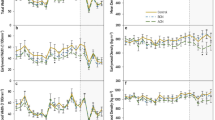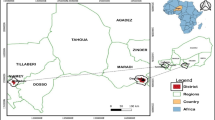Abstract
The paper deals with the stand structure and yield of black locust (Robinia pseudoacacia L.) forests mixed with white (Populus alba L.) in various proportions, partly applying a new methodological approach. The main stand structure and yield factors were determined separately for each species, measured stem by stem, using the volume functions prepared for each species. The ratio of the volumes of the species (A and B) in mixed and in pure stands (based on volume tables) was determined. A close relationship has been found between the ratio by relative total volume and the proportion (by the number of stems) of the species. The relative surplus in the volume of the mixed stands varied between 1.24–1.55 at the age of 16 compared to the control, i.e. the yield of pure stands of the species concerned. The trial has also proven that if two species have a fast initial growth rate and a similar rotation age, they can be planted in mixed stands resulting in mutual advantages.
Similar content being viewed by others
References
Assmann, E. 1970. The principles of forest yield study [M]. New York: Pergamon Press.
Busse, J. 1931. Ein Kiefern-Fichten-Mischbestand in Sachsen (Scotch pine and Norway spruce mixed stands in Saxony) [J]. Tharandter Forsliches Jahrbuch,82: 595–601.
Canell, G.R.,et al. 1992. The ecology of mixed-species stands of trees [M]. Oxford: Blackwell Scientific Publications.
Costa, M. E., Preuhsler, T. (ed). 1994. Mixed stands [C]. in Proceedings from the Symposium of the IUFRO Working Groups. Lisboa.
Fiedier, F. 1966. Zuwachs und Ertrag im Fichten-Birken-Mischbestand. (Growth and yield in Norway spruce and birch mixed stands) [J]. Archiv für Forstwesen,15: 283–291.
Harrison, G.et al. 1986. Growth and yield of Appalachian mixed hardwoods after thinning [R]. Virginia Polytechnic Institute and State University, Publ. No. FWS, 1–86.
Heyer, C. 1854. Der Waldbau oder die Forstproduktenzucht. (Silviculture or forest commodity production). B.G. Teubner, Leipzig.
Lappi-Seppala, M. 1930. Untersuchungen über die Entwicklung gleichaltriger Mischbestande aus Kiefer und Birke (Development investigations in Scotch pine and birch mixed stands) [J]. Communicationes Instituti Forestalis Fenniae,15: 1–243.
Rédei, K. 2001. The Main characteristics of Black Locust (Robinia pseudoacacia L.) [C]. In Management in Hungary. Third Balkan Scientific Conference. Proceedings. Sofia, 293–300.
Rédei, K. 2001. The impact of initial spacing on the stand structure and yield of black locust (Robinia pseudoacacia L.) stands at cleaning age [J]. Silva Balcanica,1: 71–78.
Sopp L. 1970. Volume tables. Mezögazdasági Kiadó, Budapest.
Schilling, L. 1925. Ostpreussische Kiefem-Fichtenmischbestande. (East prussian scotch pine and Norway spruce mixed stands) [J]. Zeitschr. Forst und Jagdwesch,57: 257–296.
Smith, D. M. 1986. The practice of silviculture [M]. New York: Hohn Wiley and Sons.
Tham, A. 1988. Yield prediction after heavy thinning of birch in mixed stands of Norway spruce and birch [R]. SUAS. Research Report. No. 23-36.
Wiedemann, E. 1943. Der Vergleich der Massenliestung des Mischbestandes mit der Reinbestand (Production comparison between pure and mixed stands) [J]. Allgemeine Forst- und Jaged-Zeitung,119: 123–132.
Author information
Authors and Affiliations
Corresponding author
Additional information
Foundation iterm: Part of the work was financed by OTKA support (Ref. No. T 029021).
Biography: Karoly Redel (1952-), Male, Professor, Deputy Director General of Forest Research Institute, H-1023 Budapest, Frankel Leó Str. 42–44, HUNGARY.
Responsible editor: Chai Ruihai
Rights and permissions
About this article
Cite this article
Rédei, K. Stand structure and yield of the mixed white poplar and black locust plantations on sandy ridges between the Danube and Tisza rivers in Hungary. Journal of Forestry Research 13, 103–106 (2002). https://doi.org/10.1007/BF02857230
Received:
Issue Date:
DOI: https://doi.org/10.1007/BF02857230




